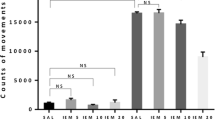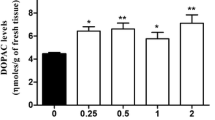Summary
The effect of two calcium antagonists, nimodipine and flunarizine, on striatal dopamine (DA) metabolism in rats was compared. Flunarizine (5–20 mg/kg i.p.) caused a dose-dependent increase in the DA metabolite, 3,4-dihydroxyphenilacetic acid (DOPAC) in the caudate nucleus. Following the 20 mg/kg dose, DOPAC levels were maximally elevated by about 50% from 2 to 12 hrs after treatment.
On the contrary, nimodipine at the dose of 20 mg/kg i.p. produced a modest decrease in DOPAC levels. Neither calcium antagonist modified DA content.
However, both nimodipine and flunarizine, at the dose of 20 mg/kg, markedly reduced the accumulation of DOPAC in the caudate nucleus induced by haloperidol (1 mg/kg). It is suggested that flunarizine, but not nimodipine, has a neuroleptic-like action, whereas the two calcium antagonists have in common the ability to attenuate the hyperactivity of DA neurons.
Similar content being viewed by others
References
Carlsson A (1975) Receptor-mediated control of dopamine metabolism. In; Usdin E, Bunney WE Jr (eds) Pre- and postsynaptic receptors. M Dekker, New York, pp 49–65
Chouza C, Caamano JL, Aljanti R, Scaramelli A, DeMedina O, Romero S (1986) Parkinsonism, tardive dyskinesia, akatisia, and depression induced by flunarizine. Lancet i: 1303–1304
Cronin MJ (1982) Some calcium and lysosome antagonist inhibit 3H-spiperone binding to the porcine anterior pituitary. Life Sci 30: 1385–1389
Dubovsky SL, Franks RD, Lifschitz M, Coen P (1982) Effectiveness of Verapamil in the treatment of a maniac patient. Am J Psychiatry 139: 502–504
Gluskin LE, Strasberg B, Shah JH (1981) Verapamil-induced hyperprolactinemia and galactorrhea. Ann Intern Med 95: 66–67
Gould RJ, Murphy KMM, Reynolds IJ, Snyder SH (1983) Antischizophrenic drugs of the diphenylbutylpiperidine type act as calcium channel antagonists. Proc Natl Acad Sci USA 80: 5122–5125
Gould RJ, Murphy KMM, Reynolds IJ, Snyder SH (1984) Calcium channel blockade: Possible explanation for thioridazine's peripheral side effects. Am J Psychiaty 141: 352–357
Grebb AJ (1986) Nifedipine and flunarizine block amphetamine-induced behavioral stimulation in mice. Life Sci 38: 2375–2382
Grebb AJ, Shelton C, Taylor EH, Bigelow LB (1986) A negative, double blind, placebocontrolled, clinical trial of verapamil in chronic schizophrenia. Biol Psychiatry 21: 691–694
Grebb AJ, Shelton RC, Freed WJ (1987) Diltiazem or verapamil prevents haloperidol-induced apomorphine supersensitivity in mice. J Neural Transm 68: 241–255
Marangos JM, Patel J, Miller C, Martino AM (1982) Specific calcium antagonist binding sites in brain. Life Sci 31: 1575–1585
Pileblad E, Carlsson A (1986) In vivo effects of the Ca2+ antagonist nimodipine on dopamine metabolism in mouse brain. J Neural Transm 66: 171–187
Pileblad E, Carlsson A (1987) The Ca++-antagonist nimodipine decreases and the Ca++ bay K 8644 increases catecholamine synthesis in mouse brain. Neuropharmacology 26: 101–105
Rossetti ZL, Mercuro G, Rivano AC (1983) A study of the factors affecting flow gradient analysis of catecholamines, DOPA and DOPAC by ion-pair liquid chromatography with electrochemical detection. Life Sci 33: 2387–2395
Shah AB, Poiletman M, Shah NS (1983) The influence of nisoldipine — a “calcium entry blocker” on drug induced stereotyped behavior in rats. Prog Neuropsychopharmacol Biol Psychiatr 7: 165–173
Yamauchi T, Fujisawa H (1980) Involvement of calmodulin in the Ca2+-dependent activation of rat brainstem tyrosine 3-monooxygenase. Biochem Int 1: 98–104
Author information
Authors and Affiliations
Rights and permissions
About this article
Cite this article
Fadda, F., Gessa, G.L., Mosca, E. et al. Different effects of the calcium antagonists nimodipine and flunarizine on dopamine metabolism in the rat brain. J. Neural Transmission 75, 195–200 (1989). https://doi.org/10.1007/BF01258630
Received:
Accepted:
Issue Date:
DOI: https://doi.org/10.1007/BF01258630




